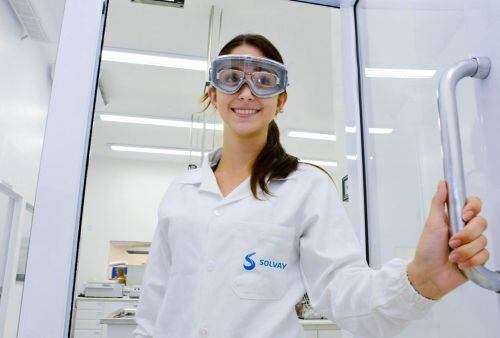Vanilla bean prices surged in the early 2000s before crashing and then stabilizing for some years, Edouard Janssen, SVP and general manager at Solvay Aroma Performance, Americas, told FoodNavigator-USA.
However, prices have surged again since 2015 as more food manufacturers have switched from vanillin to vanilla bean extract as part of natural and clean label drives - ignoring what Sentrex Ingredients exec Naushad lalani described in a report penned in April 2017 as "a fundamental crop reality... the global availability of vanilla beans was insufficient to flavor everything with natural vanilla. It's akin to squeezing an elephant into a Volkswagen."
This, coupled with cyclones and ongoing challenges in Madagascar (which accounts for 80-85% of the world’s production) has sent prices into the stratosphere, Janssen told FoodNavigator-USA: "A couple of years ago a kilo fell to around $25-30/kg, but now we’re talking about prices of $500-600/kg.”
While vanilla supplier Nielsen Massey says it is “cautiously upbeat” about the size and quality of the 2017 vanilla crop in Madagascar, demand is likely to significantly outstrip supply for years to come, said Janssen.
Natural vanillin options
For food and beverage manufacturers unable to pay sky-high prices, but committed to avoiding artificial flavors, Solvay launched its Rhovanil natural vanillin (which can be labeled as ‘natural flavor’ in the US and Europe), produced from ferulic acid (derived from rice bran) via a fermentation process using a naturally occurring yeast in 2001.
It’s up to 20 times more expensive than artificial vanillin, but considerably cheaper than vanilla bean extract, and it’s generating “strong double-digit growth,” said Janssen.
Solvay has since developed a suite of vanillin-based products under the Vanifolia brand combining Rhovanil natural vanillin and other natural flavors – in some cases from vanilla beans - in order to more closely match the complex notes (smoky, spicy, botanical, sulfury, sweet, creamy, medicinal, cooked, fatty, and floral) associated with natural vanilla bean extract, and this range is also notching up healthy double-digit growth, albeit from a small base, said Janssen.
“A lot of companies that have been using vanilla extract [but want something more affordable] want something that’s closer to the flavor profile of vanilla bean extract [as opposed to straight vanillin – which is just one component of vanilla].”
While there are other players in the ‘natural’ vanillin market (for example via bioconversion of eugenol), companies looking for a global solution like working with Solvay because its Rhovanil-natural-based products are considered natural in multiple regions, whereas some rival bio-vanillin products are not, claimed Jean Pierre Cuif, global nutrition business manager, Solvay Aroma Performance.
“Lots of our customers are large global players and they want a global solution that’s natural.”
Solvay - which acquired Rhodia, an established supplier of vanilla flavors, in 2011 - manufactures vanillin from plants in Louisiana; France; and China. It offers:
- Rhovanil vanillin and Rhodiarome ethylvanillin ('artificial' vanilla flavors synthesized from guaiacol)
- Rhovanil Natural vanillin (which can be described as 'natural flavor' in the US and the EU - and is made from a fermentation process using a naturally-occurring yeast and ferulic acid from rice bran).
- Vanifolia natural functional solutions (which combine Rhovanil Natural and other natural ingredients and can also be described as 'natural flavor' in the US and the EU).
- Vanifolia Bean (which combines Rhovanil Natural and other natural ingredients, including those from vanilla beans, for a more authentic vanilla taste, and can also be described as 'natural flavor' in the US and 'natural vanilla flavor' in the EU).
- Govanil (a range of vanilla flavors particularly well-suited to masking off notes in high protein foods and longer-lasting intensity in chocolate products. Natural and artificial options are available).
“Eight out of 10 consumers want food and beverage products that have a ‘natural’ label claim on them. Only three out of 10 can actually afford these products. Quite candidly, ‘natural’ and ‘clean label’ products for the most part have been limited to a niche, for the most part an elite group of consumers. We want to change that by providing value to manufacturers and ultimately consumers so that they can recalibrate their lifestyle with products that address their health needs without compromising taste and affordability.”
Edouard Janssen, Solvay Aroma Performance, Americas
VANILLA BEAN PRICING AND SUPPLY: 'We walked away from the trip feeling cautiously upbeat...'

“The Nielsen-Massey leadership team recently traveled to Madagascar where we toured several vanilla farms and met with growers, processers, distributors, exporters and government officials. We walked away from the trip feeling cautiously upbeat about prospects for the 2017 harvest, both in terms of its size and quality…
“Even with the impact of losses from Cyclone Enawo, it now appears that the country will export between 1300 and 1600 tons of vanilla beans this year versus 1100 tons last year. Many of the poor harvesting and processing practices that have plagued the island in recent years appear to have been curbed...
“Despite this upbeat news, we expect vanilla prices to remain stable for the near future. Global demand for pure and natural vanilla remains strong, and it will take years for the sector to begin rebuilding depleted inventories.” Nielsen Massey, October 2017
“Madagascar will have an even more dominant position on the global vanilla stage in 2017 as compared to 2016 as virtually all speculative and carry over inventories of vanilla beans have been mostly liquidated. The expected increase in vanilla production from other origins has not yet materialized and it is unlikely we will see a significant impact before 2018. Therefore what transpires in Madagascar this season will determine the trajectory of the global vanilla trade…” Aust & Hachmann (Canada) Ltd, August 2017
“I’ll also say that we have taken several moves on vanilla as the cost of vanilla beans has moved from single digits per pound to well over $200 a pound [$440/kg] and that's been well understood in the industry and so their price increases have been accepted.”
Lawrence Kurzius, president and CEO, McCormick, Q3 2017 earnings call, Sept 28, 2017
'We’ve analyzed some competitor products and have been horrified to find traces of toluene in them'
When it comes to ‘artificial’ vanillin and ethyl vanillin, meanwhile – sales of which are growing 3-4% YoY at Solvay - companies are also wary of some of the solvents being used in the industry such as toluene, claimed Janssen, who said Solvay had switched to using food-grade bio-ethanol as a solvent several years ago in a bid to boost its sustainability credentials and further differentiate itself from Chinese competitors.
“We’ve analyzed some competitor products and have been horrified to find traces of toluene in them.”
Some rivals, he claimed, used the ortho nitro chloro benzene (ONCB) process to obtain guaiacol, a key intermediate for vanillin production, which had raised safety and environmental concerns and can sometimes leave chlorinated impurities in the final product, despite purification steps.
Solvay, by contrast, uses a catechol route to obtain guaiacol at its plants in the US and in France, and uses no toluene and no methanol. “We use a chlorine-free process.”

Solvay has recently raised the price of its artificial vanillin and ethyl vanillin by 15% across North America to reflect rising raw material, energy and transportation costs and improvements in purity.
Our big customers want non-GMO – and that extends to processing aids
Another option - vanillin manufactured from the fermentation of glucose with a genetically engineered baker’s yeast, developed by Evolva and licensed to flavors giant IFF for commercialization and distribution in 2014 - has not disrupted the market in the fashion that some commentators had predicted it might, mainly because food manufacturers are wary of anything involving GMOs and synthetic biology in particular, speculated Janssen.
“Our big customers want non-GMO – and even if it’s just the processing aid that's a GMO, they don’t want it, so we don’t see it as a threat – we don’t see it on the market at all.”
(Evolva and IFF have not responded to questions from FoodNavigator-USA about the availability or performance of the vanillin developed via their collaboration.)
As the microbe that expresses the vanillin serves as a processing aid and is not present in the final product, the vanillin would not be subject to US federal GMO labeling requirements (which have yet to be implemented) and could technically be used in products with ‘no-artificial’ claims in the US given that the FDA sees fermentation as an acceptable technology for natural flavors.
On the other hand, the Non-GMO Project says foods containing ingredients made with synthetic biology cannot carry its Non-GMO Project Verified label, while the debate over what is ‘natural’ for overall food product labeling has now moved well beyond what is actually in the ingredients list to extend to production methods, processing aids and so on.
Growth opportunities
So where are the growth opportunities for vanillin?
Chocolate remains a huge market, not just because vanilla and chocolate taste great together but because vanillin can mask the off notes in cacao, said Janssen.
“But we’re seeing particularly strong growth in health and wellness products made with vegetable proteins – things like pea protein – and this is where we are getting a lot of traction in the market because we specialize in masking the off notes from things like pea protein.
“We are also seeing strong growth in products sweetened with stevia, or featuring bitter-tasting vitamins, fish oil and other functional ingredients, plus growing use of vanillin as a flavor enhancer with things like strawberry and chocolate.”
VANILLA FLAVOR OPTIONS
Vanilla beans: Less than 1% of vanilla used in the food industry is derived from vanilla beans, which are primarily grown in Madagascar.
Guaiacol: Most vanillin is synthesized from integrated catechol and is considered to be an artificial flavor (although it can also be listed on labels as vanillin).
Paper waste: Vanillin can be made from lignin, from wood (see Borregaard in Norway) which some foodmakers prefer to vanillin made via guaiacol. However, it is not considered 'natural' by regulators.
Fermentation from ferulic acid from rice bran or other crops: Solvay, which uses a naturally-occurring yeast and ferulic acid to make its Rhovanil natural vanillin, says this product can be labeled as ‘natural flavor’ in the US and Europe.
Fermentation from sugars with a genetically engineered baker’s yeast: Swiss biotech company Evolva partnered with IFF a few years ago to commercialize vanillin produced in this way, but IFF has not responded to questions about whether it is still available and how it is performing.
